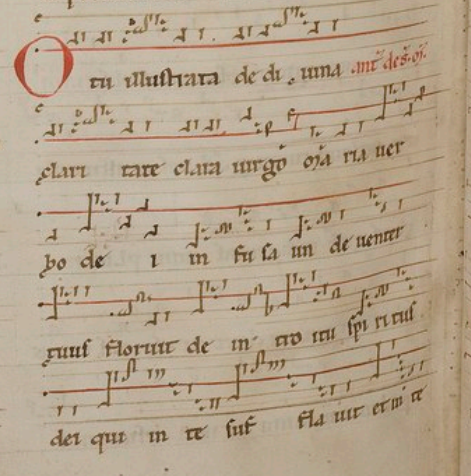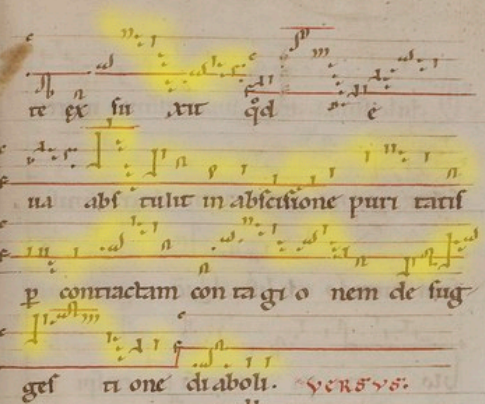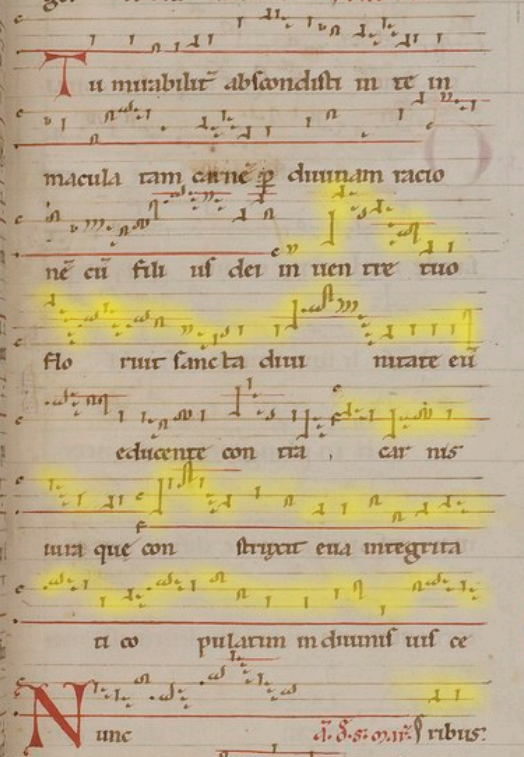February 2nd is the feast day for the purification of the Virgin Mary. It is also the feast of Candlemas – a celebration of the coming of light. I have selected o tu illustrata as my appropriate chant. It is a votive antiphon for the VM, who, according to the text, is lit by divine brightness – so it rather fits the double bill.
I didn’t realize before I started work on o tu illustrata that I would need to make some tricky decisions. Here’s why:
This chant is in only one manuscript (the Riesencodex), so comparison to resolve any notation issues is impossible. The modern edition most often relied upon (originally by Otto Müller and published in the Beuroner Kunstverlag edition) diverges wildly from the note pitches indicated in the manuscript (see below, where I have indicated in yellow where most interpreters have altered the original), and all the recordings I have so far heard either follow this modern edition, or make their own amendments (e.g., Sequentia) to keep the chant clearly centred on re.
I do understand why – and if this were a normal antiphon, with a psalm cadence attached, I might agree (each mode has its own psalm cadence, and so it would be tricky if the antiphon shifted between modes).
But I have decided to sing this chant in its original version, following the manuscript, and here are my reasons:
- This is not a antiphon that would have been sung with a psalm. It’s a votive antiphon and would have been sung separately, at the beginning or end of an office. It has its own “versicle” written out. Therefore, it does not need a psalm cadence, and Hildegard was potentially free to wander.
- While there are a few scribal errors in the manuscripts, usually the errors relate to a small group of neumes. Take my last chant, for example: in the Riesencodex the responsory rex noster begins on re, but the rest of the chant is clearly in mi mode. Fortunately, rex noster is also in the Dendermonde manuscript, where it does starts on mi, so my decision to treat the first neume in the Riesencodex as a clerical error was quickly made. In o tu illustata, however, long sections of chant are treated by most interpreters as incorrectly pitched (see below). But errors of this length? It’s easy to imagine a scribe being briefly distracted and writing a handful of neumes on the wrong line; it’s harder to imagine a scribe perpetuating his or her mistake line after line, when at the beginning of each line there is a clear reminder of where the do and the fa are situated on the stave.
- Allowing modal shifts like this makes for a very interesting chant :-).
- If the antiphon is repeated after the versicle, which I presume it would have been but which most interpreters do not do, the shifting modes make musical sense to my ear.
One last remark: following the original notation, a vocal range of two and a half octaves is required. I have transposed the chant down a fourth so as to be able to sing it.
If you have any thoughts on this, I’d love to hear from you. Please don’t hesitate to leave me a comment!
#hildegardvonbingen #chant #facsimile
o tu illustrata
O you, illuminated by the divine brightness, bright virgin mary, infused by god’s word, how your womb flowered by the coming of god’s spirit, which gave you breath, and, in you, you exhaled what eve removed, withering purity through the carnally touched contagion of the devil’s suggestion. You miraculously hid within yourself the immaculate flesh, that through divine reason with the son of god flowered in your womb, he being brought forth by divine holiness, against the laws of the flesh that eve constructed, in the whole coming together in divine flesh.





Post a Comment